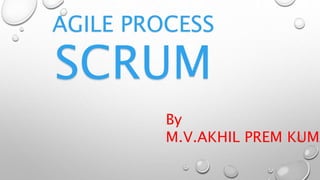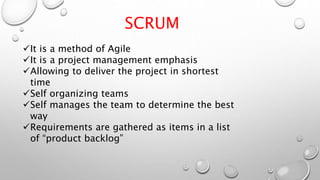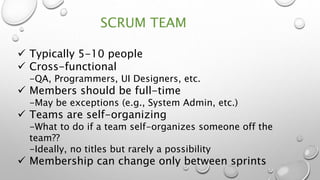Scrum
- 2. SCRUM ïžIt is a method of Agile ïžIt is a project management emphasis ïžAllowing to deliver the project in shortest time ïžSelf organizing teams ïžSelf manages the team to determine the best way ïžRequirements are gathered as items in a list of âproduct backlogâ
- 3. WHY SHOULD WE USE SCRUM ïžFaster time to market ïžManage changing priorities ïžEnhance software quality ïžProject visibility
- 5. SPRINT ïž Scrum has a fundamental 30-day development cy called a Sprint ïž It is preceded by., o pre-Sprint activities o post-Sprint activities
- 6. SprintInputs Tested Code Change No changes during the sprint ïž Plan sprint durations around how long you can commit to keeping change out of the sprint
- 7. SCRUM FRAMEWORK ïž Roles : Product Owner, Scrum Master, Team ïž Ceremonies : Sprint Planning, Sprint Review, Sprint Retrospective, & Daily Scrum Meeting ïž Artifacts : Product Backlog, Sprint Backlog, and Burn down Chart
- 8. ïž Define the features of the product ïž Decide on release date and content ïž Be responsible for the profitability of the product (ROI Prioritize features according to market value ïž Adjust features and priority every iteration, as needed Accept or reject work results. Product Owner
- 9. ïž Represents management to the project ïž Responsible for enacting Scrum values and practices Removes impediments ïž Ensure that the team is fully functional and productive ïž Enable close cooperation across all roles and functions Shield the team from external interferences SCRUM MASTER
- 10. ïž Typically 5-10 people ïž Cross-functional -QA, Programmers, UI Designers, etc. ïž Members should be full-time -May be exceptions (e.g., System Admin, etc.) ïž Teams are self-organizing -What to do if a team self-organizes someone off the team?? -Ideally, no titles but rarely a possibility ïž Membership can change only between sprints SCRUM TEAM
- 11. SPRINT PLANNING MEETING Sprint Planning Meeting Product Backlog Team Capabilities Business Conditions Technology Current Product Sprint Backlog Sprint Goal
- 12. ïž 1st Stage: -Creating Product Backlog -Determining the Sprint Goal. -Participants: Product Owner, Scrum Master, Scrum ïž 2nd Stage: -Participants: Scrum Master, Scrum Team -Creating Sprint Backlog Parts of Sprint Planning Meeting
- 13. ïž Requirements for a system, expressed as a prioritiz Backlog Items ïž Is managed and owned by a Product Owner Spreadsheet (typically) ïž Usually is created during the Sprint Planning Meetin ïž Can be changed and re-prioritized before each PM Product Backlog
- 14. ïž Scrum team takes the Sprint Goal and decides what tasks are necessary ïž Team self-organizes around how theyâll meet the Sp ïž Manager doesnât assign tasks to individuals ïž Managers donât make decisions for the team Sprint is created From Sprint Goal to Sprint Backlog
- 15. ïž A subset of Product Backlog Items, which define the work for a Sprint ïž Is created ONLY by Team members ïž Each Item has itâs own status ïž Should be updated every day Sprint Backlog
- 16. Advantages ïž Completely developed and tested features in short iterations ïž Simplicity of the process ïž Clearly defined rules ïž Increasing productivity ïž Self-organizing ïž Each team member carries a lot of responsibility ïž Improved communication ïž Combination with Extreme Programming
- 17. Disadvantages ïž âUndisciplined hackingâ (no written documen ïž Violation of responsibility ïž Current mainly carried by the inventors
- 18. THANK Q


















